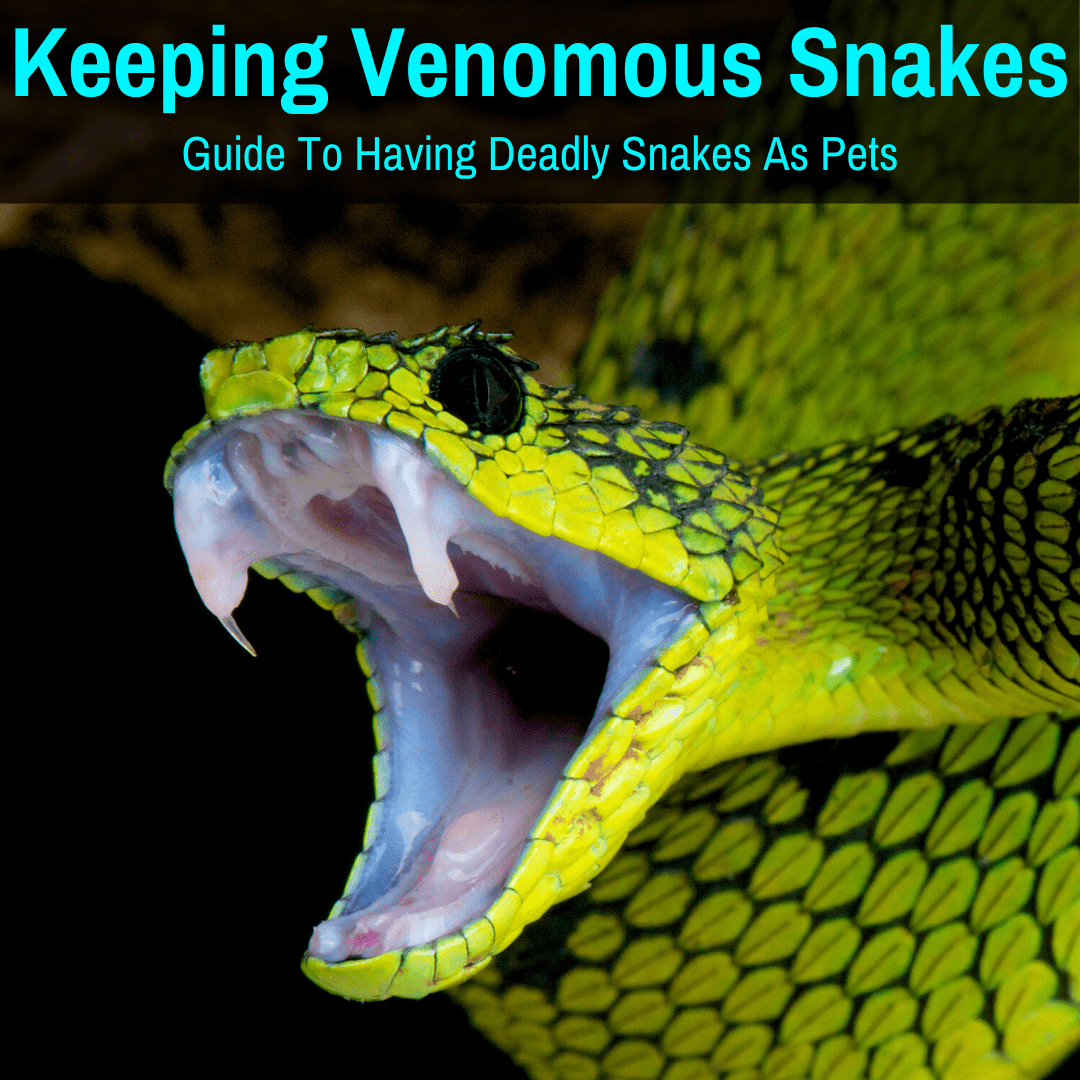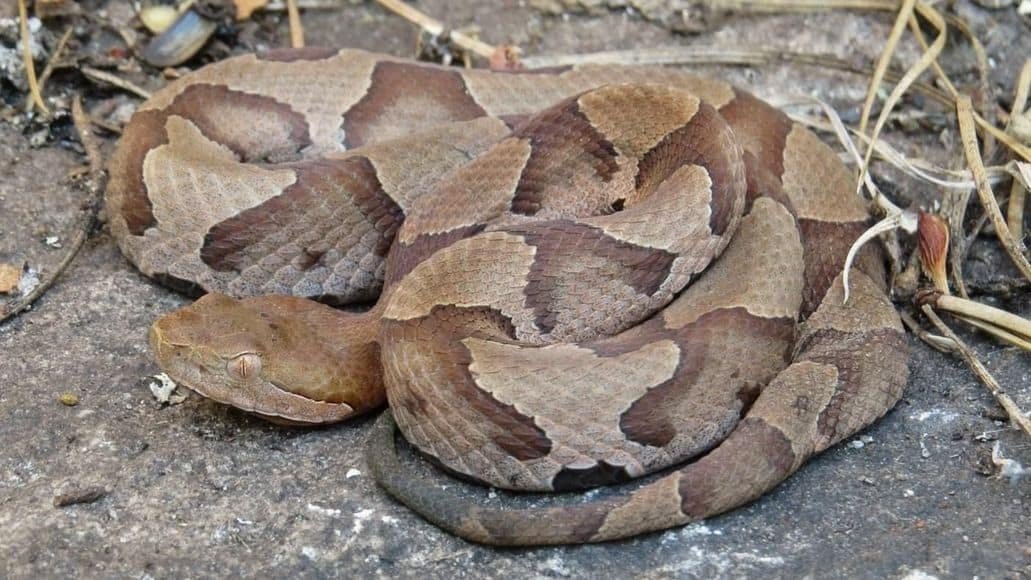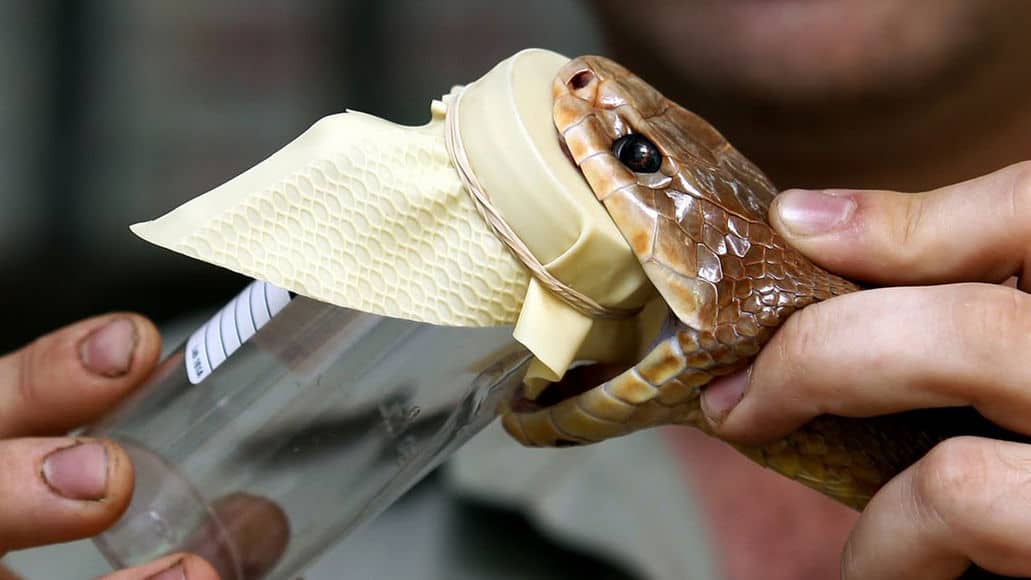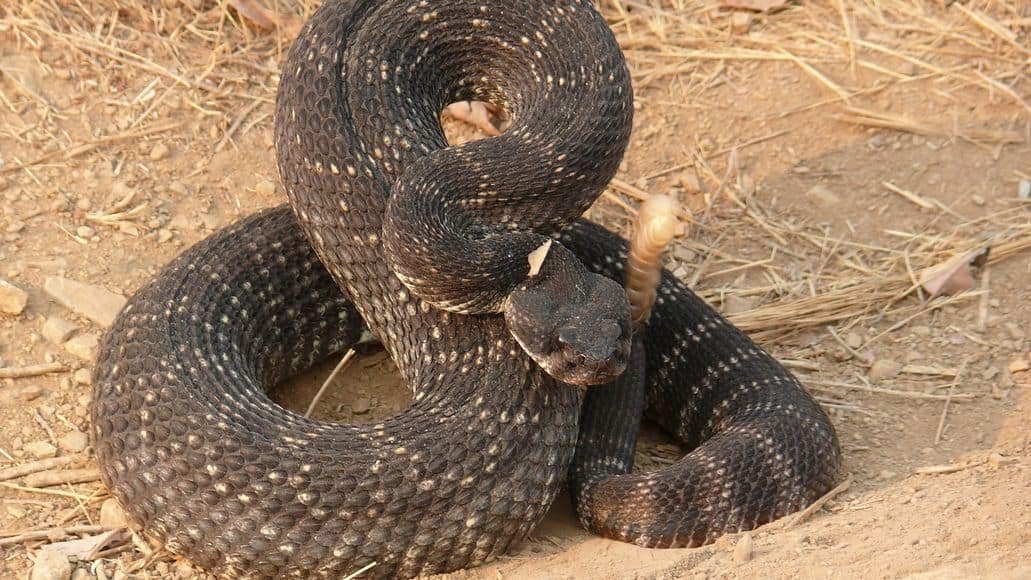
They exist on six continents and are feared on all six. For good reason.
But we also find them fascinating. And some of us find them so fascinating that we want one (or more) of our own.
But keeping venomous snakes is not easy.
They are aggressive and many have venom potent enough to kill humans. They kill people every year.
But the truth is: venomous snakes rarely bite humans. It’s usually only when we intrude on their territory, that they strike.
That’s why keeping a venomous snake is not as crazy as some might think. You just have to know what you’re doing. And be willing to deal with the bureaucracy.
In most areas of the world, the hardest part of owning a venomous snake is actually getting the permits.
Table of Contents
Keeping Venomous Snakes
The private possession of dangerous snakes is popular, but many US states ban private ownership of venomous snakes.
Because of the potential dangers with these animals, some states simply prohibit keeping them all together, while others restrict possession to certain species.
It is important to know the local laws. Keeping venomous snakes in your particular state may not be legal at all, or it may require some kind of permit or license.
The laws vary greatly. In Texas, for instance, it is illegal to own any snakes that are native to the environment.
There are good reasons for these laws.
Many snake owners don’t really understand all the ins and outs of handling and taking care of these animals. And when not properly cared for, venomous snakes can pose a danger to the community, as well as to emergency responders.
Ensuring The Future Of Snakes
It is important to do your research about capturing a snake. The answer to keeping a venomous snake in the USA is not as simple as you’d like.
In many states, more snakes are being added to the list of endangered animals threatened by human intervention.
People wanting to keep venomous snakes often get angry at the laws.
They don’t realize the laws are there to ensure the future of snakes. Their very existence is maintained because people aren’t allowed to simply catch, buy or own any reptiles they please.
Examples Of Venomous Snakes
The most well know poisonous snake in the US is the rattlesnake, specifically the Black Diamond Rattlesnake.
It has several different subspecies and their toxic venom attacks nerve endings. This means you’ll need a higher dose of antivenom for treatment.
The copperhead is responsible for the most bites of any snake.
This isn’t because it is more aggressive, but because the snake freezes when threatened as opposed to slithering away. Step on a Copperhead and you’re likely to be bitten.
Even the least deadly venomous snakes such as the Copperhead can cause serious reactions from just one bite.
What gives these snakes a bad name is that many inexperienced people are able to obtain these reptiles. They are readily available in states where they are legal.

In North America, the Eastern Diamondback rattlesnake is the largest and most venomous snake. It has the largest fangs among the Rattlesnake species AND potent venom. The snake’s bite has a mortality rate as high as 30%.
Approximately 10,000 venomous snakebites occur in the United States each year. Some of these bites are from snakes kept as pets.
Many fatalities are also reported each year. In June 2018, 70-year-old golfer Lawrence Walters was bitten by a Rattlesnake on the ankle. He was playing golf at Spearfish, South Dakota. CPR was performed at the clubhouse but he was pronounced dead at the hospital.
Most snakebites occur between April and October. This is when the weather is warmer and outdoor activities are popular.
With their potential to bite and kill, why do people keep venomous snakes as pets?
- Some people breed them to make money, selling them to others
- The demand to own an unusual pet feeds the supply
- Some people keep these snakes for the venom they produce
- Some people just want to impress by having an exotic pet, and a dangerous one at that
- Venomous snakes are actually undemanding, fairly low maintenance pets
Handling Venomous Snakes
Handling venomous snakes can be dangerous. Keeping a venomous snake is totally different from keeping a ball python or a corn snake.
It should go without saying that, unless you’re a trained venom extractor, you shouldn’t be picking up a poisonous snake with your hands.
Even herpetologists scoop specimens up with a social snake hook. The safety of both handler and snake is a top priority at all times. Handle snakes correctly to reduce injuries to both yourself and your pet.
Tips for ‘Working’ With Your Snake
- Look at your pet snake and understand the serpent’s for clues on how best to handle it
- It’s a good idea to always have someone close by when handling venomous snakes
- The idea is to handle venomous snakes as little as possible – only when you really need to
- Always wash your hands after handling snakes
- Proper snake handling equipment is absolutely necessary for venomous snakes
Those who want to show off and insist on using their bare hands are just asking for trouble. The only time it is acceptable to hold a toxic snake with your hands is for milking.

The professional snake handler holds the back of the snake’s head with the thumb and index finger. Immobilizing the snake’s head, the handler puts their fingers on the venom glands.
The handler forces the snake’s mouth open, pushing its fangs through a latex membrane stretched over the snake milking jar.
When handling venomous snakes, backup is always a wise strategy. No matter how skilled a snake handler, you may require the services of 911 and anti-venom. Whether you handle deadly snakes for pleasure or for a living, caution is key.
Snake handlers often deal with venomous snakes that could bite them. If a handler knows that he or she will be working with a particular type of venomous snake, they should keep antivenom available. If bitten, the antivenom can be injected immediately into the bloodstream to counteract the venom.
Wit such a dangerous job, you expect they are well compensated, right? Wrong. How much does a snake milker make? The average snake milker salary is only around $35,000 per year.
Things You’ll Need To Own A Venomous Snake
Watch any snake program on TV and you’ll quickly discover that the universal tool for handling venomous snakes is the snake hook. This is a pole of various lengths with a 90° angle hook.
The end is rounded to prevent injury to the animal and the top should have a rubber or wooden handle for optimum control.
Any snake keeper should have an assortment of snake hooks to accommodate any size of snake. Popular lengths are 12 to 16 inch hooks.
Snake hooks keep venomous snakes out of striking range while moving them or displaying them. Snake tongs are a similar tool that perform the same function. They are essentially grasping devices to restrain large, aggressive snakes.
The tongs are roughly 24 to 60 inches long. They have with a pistol-type grip and lever as well as a couple of 6 inch fingers at the bottom end. These are connected to the long rod and clamp onto the snake.
DocSeward Snake Hook
The Copperhead Series brings snake owners a rugged 33″ hook. Crafted in the USA, the hook is made from copper and stainless steel. The hook has a rubber grip and is lightweight.
Two options are available: Standard and Max. The Standard is ideal for working with smaller snakes in a captive environment while the Max design works well for larger snakes.
Fnova 52″ Extra Heavy Duty Snake Tongs
These professional snake catcher and grabber tongs work for small and large snakes. There are longer and shorter tongs available, but these are a nice all-around model.
The have a serrated zigzag jaw that keeps the snake in place, preventing its forward motion, while protecting the animal from harm. The broad jaws allow for maximum holding pressure, without hurting your snake. The tongs are made from stainless steel with a non-slip rubber grip.
Repti Zoo Glass Terrarium
Different reptiles have different needs and the terrarium you buy or build will need to accommodate the type of snake you want. Some venomous snakes can grow quite large.
Snakes like different areas to hide, sun, swim and cool down in. Choose a terrarium in keeping with the size your snake is or will become. Make sure your enclosure is totally escape proof.
The nice thing about a terrarium from Repti Zoo is that is comes fully assembled right out of the box. It has a raised waterproof bottom frame and you can fit in a substrate heater.
You can tell that this enclosure has been designed by herpetologists. There are multiple different sizes which ensure an excellent environment for your snake.
The one pictured here 36 x 24 x 18 inches. The dual front opening doors allow for easy access. A specially designed lock is an additional safety measure against snakes with escape on their minds.
The full-screen top ventilation is completely removable and encourages UVB and infrared penetration. Five closable wire inlets mean you can install water features, heating, sensors etc.
iPower Reptile Heating Pad
These are fantastic tools for providing heat to your snake enclosure. The heating pad conducts heat to the enclosure floor and substrate. This energy-efficient glass terrarium heater is UL approved to guarantee safety and quality.
It comes with US standard plug and requires 110 volts – no need for an extra adapter. The pad is perfect for tropical and desert loving reptiles and allows you to control the temperature from 32° to 95° F (0° to 35° C). The pad is waterproof and moisture-resistant.
UV Light
Reptiles know how much heat and light they need and will expose themselves to it accordingly. But they need a source. Captive snakes need a suitable area for basking in heat, light, and UVB gradients, just like they would in the wild.
This lamp from Lucky Herp produces UVA and UVB light and heat, mimicking sunlight. The mercury vapor bulb provide your venomous snake with warmth and the UV light stimulates vitamin production. It provides the ideal light for snakes and is compatible with all enclosures.
How To Get A Venomous Snake Permit
Each American state has different laws regarding exotic pets. In some states, you can have a pet snake while in others you can’t. Many states have cryptic rules regarding exotic animals as pets.
Some states at least list which species are legal and which aren’t. Many states require permits that are all but impossible to obtain and which aren’t distributed to ordinary people just looking to keep an interesting pet.
In Texas, for instance, permits are available from the Texas Parks and Wildlife Department. You can also request a copy be sent to you through the mail.
Should you have any questions regarding these permits or the application process, you can email license@tpwd.texas.gov. In Maryland, applying for a permit requires a $10.00 annual fee. The license in this region is valid from the date of issue until December 31. Both of these states make it fairly easy.
Owning A Venomous Snake In Different States And Australia
We’ll only cover a few highlights here. For a more complete overview, read Snake Laws in the US.
Michigan
The State of Michigan is known for its unspoiled nature. It has the nation’s longest freshwater coastline, huge lakes, sandstone cliffs, a marine sanctuary, and state parks. The snakes of Michigan are found in these different landscapes – woodlands, grasslands, desert-like areas, and marshes.
There are some 18 species of snakes found in Michigan, playing an important role in the state’s ecosystems. The Eastern Massasauga Rattlesnake is the only venomous snake in the state of Michigan.
It prefers wetland habitats. The snake can reach a little more than 3 feet and it has a rattle on the tail. These snakes are shy and try to avoid humans.
Michigan’s venomous snake receives federal protection as a threatened species under the Endangered Species Act. The shy, non-aggressive, reclusive rattler is listed as threatened and endangered in every state in which it lives. It is often killed when encountered. People recoil at the fangs and rattling tail as it tries to protect itself.
Pennsylvania
Owning venomous snakes in Pennsylvania can be confusing. Pennsylvania is notorious for having complicated requirements for keeping exotic pets.
Their hard-to-get exotic wildlife possession permit requires a 2-year hands-on experience from an approved facility for the specific species requested. The Pennsylvania Game Commission provides some conflicting information on what you need to do to be legal with snakes and other exotic pets.
Pennsylvania regulates exotic pets, and nearly all exotic animals are illegal without a permit. Not only is it illegal to bring exotic creatures into the state of Pennsylvania without the proper permits, just traveling through the state can get your exotic pets confiscated.
There are three venomous Rattlesnake species native to Pennsylvania: Timber, Eastern Massasauga and the Northern Copperhead Rattlesnakes. All three are pit vipers. Officials believe people should have permits for animals native to the state too. The Pennsylvania Game Commission handles the distribution of these permits.
If you want to get a permit for a native species, you can, but then you also need to meet the 2-year experience requirements. Also, the facility where you get your experience needs to submit a letter detailing your experience. The snake cage must be meet the provided specifications. It will be inspected. Once approved, a permit is granted.
California
To legally keep venomous snakes in California you need to apply to the Department of Fish and Wildlife for a permit. California has some strict laws on owning animals.
They have a detailed list of animals that can’t be kept as pets. Some of these animals would pose a threat to native wildlife or maybe they’re not domesticated and should be left in the wild.
All native reptiles in California are protected under California Fish and Game laws and may not be captured. There are several species of rattlesnakes in California which aren’t considered endangered and which California residents can capture in a legal manner without a permit.

Australia
Australia has some seriously venomous snakes. The Land Down Under actually has more venomous snakes than non-venomous snakes.
The most deadly is the Eastern Brown snake. Extremely venomous, the snake can grow to about 2 meters in length. It is fast and agile and can fit into the tightest spot when trying to hide.
The Eastern Brown raises the front part of its body into an ‘S’ shape ready to strike forward. The snake’s venom contains powerful neurotoxins and blood coagulants. No other snake in Australia has caused as many human deaths as this snake.
The most venomous snake in Australia, and indeed in the world, is the Inland Taipan. It grows to be about 2 meters long.
Although extremely venomous, this serpent is shy and reclusive. Instead of striking out at human beings, it prefers to escape. That is why it doesn’t cause nearly as many human deaths as the Eastern Brown, despite being far more venomous.
Keeping Venomous Snakes In Australia
Keeping venomous snakes in Australia is looked upon as a privilege and not a right. The keeping of reptiles is regulated differently in the different states, and laws can change.
You need to apply for a license before you can obtain a reptile and you need to get it from a legitimate source. It is even legal to privately own an Inland Taipan in Australia, but you need to obtain the highest venomous class reptile license.
In Australia, anyone wanting to keep a venomous snake in captivity must hold a Specialist Keep and Sell Permit. Venomous snakes are classed as ‘Specialist Animals’ and they can only be acquired legally.
Venomous snakes are protected and a permit is required to take them from the wild. Anyone applying for a permit to keep and sell a venomous snake must show that they have the means and experience to safely and properly care for the snake.
There’s An Illegal Trade Happening Online
You need to find out what your state’s exotic pet laws are. You need a permit to own a deadly serpent in many states, while in others you don’t.
A little bit of research will tell you that there are people who don’t care at all about permits and laws. Venomous snakes are being traded online. Illegally. Sellers violate conservation laws when selling venomous snakes.
The Internet has many ads offering to sell the likes of cobras and rattlesnakes. Most sellers act responsibly and ask for proof of permits, but others could not care less.
There are sellers who sell their venomous snakes with no questions asked. The people who buy these snakes have no permits and no experience in handling the venomous snakes they buy. You can even find rare and highly dangerous snakes like the Golden Lancehead.
When you start researching permits for keeping venomous snakes, it may seem that the United States doesn’t favor people keeping venomous reptiles. I suppose you could say they’re being careful for good reason.
The news often reports on reptile escapes and bites, not to mention legal violations. Incidents like these have, unfortunately, negatively affected keeping reptiles as a hobby. Many states now have new laws regulating the possession of venomous reptiles.
If you’re uncertain about the laws in your state, you can usually find them online. An Internet search on your state and the words ‘permits for keeping venomous snakes’ will lead you to information on permits and legislative laws.
Sources for information:
- Your state’s Department of Natural Resources
- The non-game division of the Department of Fish and Game
Owning A Venomous Snake: Final Thoughts
Reptile keeping is a popular and fascinating hobby. To enjoy responsible keeping, and perhaps breeding, of venomous reptiles, it is important to do it legally. It’s not really a fun hobby, if you are always under a shroud of nervousness, because of unlawful conduct.
Laws and permits are in place for the safety and well-being of snakes and their owners. Safe snake handling is an acquired skill and it requires complete knowledge about snakes.
Have doubts about how to care for a venomous snake?
Contact a responsible breeder or vendor of the particular reptile you’re interested in keeping. If you need help with the permits and laws in your state and area, contact the Department of Natural Resources or Fish and Game.
Too many snakes are abandoned because people didn’t realize what they were taking on. In some cases, the owners were surprised by the snake’s temperament or by the size they grow to and the amount of space they need.
You might be wondering “Can you defang a snake?” The answer is yes, but you really shouldn’t. If you feel the need to defang your snake, you probably shouldn’t be caring for that snake in the first place.
Before capturing or buying a venomous snake, do your research and know what you are getting yourself into. Snakes are fascinating, convenient, low maintenance pets suited for people with busy lifestyles.
When you’re knowledgeable about the habits of venomous snakes, allowing one into your home can bring a lot of happiness. You may feel that your hunt for an extraordinary pet is at last over.





Leave a Reply